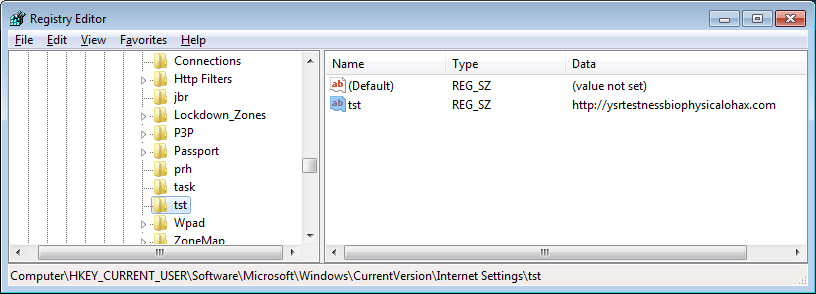The DGA of Banjori
The malware in this blog post is also known as BackPatcher, Banjori, BankPatch and MultiBanker 2
The DGA in this blog post has been implemented by the DGArchive project.
For more information about the malware in this blog post see the Malpedia entry on Banjori.
This post analyses the domain generation algorithm (DGA) of the banking trojan Banjori, also known as MultiBanker 2 or BankPatch/BackPatcher. The DGA was active mostly between April and November of 2013 (at least thats when I found most seeds). Two blog posts on kleissner.org [1] [2] document many interesting properties of the malware, including some aspects of the DGA.
Although the malware family and its DGA might no longer be relevant, I still liked the malware for two reasons:
- The malware’s disassembly is very clean and simple to reverse, many parts were probably written in assembly.
- The DGA uses a multivariate recurrence relation with some interesting properties.
I reversed this fairly recent sample from malwr.com, shared by the uploader for anyone to download.
The DGA
The callback loop for the examined Banjori sample in IDA’s graph view looks as follows:

The malware tries to post various data with subroutine connects (offset 2B113). The target domain of the POST is stored in a global variable which does not appear in the above graph view. The first such domain is hard-coded. In case the domain name can be resolved, the malware POSTs data to the CnC-server and reads its response (not shown). Valid responses end with "chek", see offset 2B129. Only if Banjori receives such a response from the CnC server will it consider the callback a success and return. In all other cases, the malware enters a check_connectivity_loop (offset 2B14B):
000282CB check_connectivity_loop proc near
000282CB
000282CB push offset aWww_google_de ; "www.google.de"
000282D0 call ds:gethostbyname ; ws2_32.gethostbyname
000282D6 test eax, eax
000282D8 jnz short locret_282E7
000282DA push 5000
000282DF call ds:Sleep ; kernel32.Sleep
000282E5 jmp short check_connectivity_loop
000282E7 ; -------------------------------------------------------------
000282E7
000282E7 locret_282E7:
000282E7 retn
000282E7 check_connectivity_loop endp
This loop tries to resolve www.google.de every 5 seconds until it succeeds — indicating the host has internet connectivity.
Every failed POST is retried a second time for the same domain (see offsets 2B0EE and 2B146). After the second failed attempt, Banjori calls generate_and_save_next_domain. This routine generates a new domain based on the previous:
000281BD push ds:pDomain
000281C3 call next_domain
The routine next_domain is:
00028242 next_domain proc near
00028242
00028242
00028242 prevdomain = dword ptr 8
00028242
00028242 push ebp
00028243 mov ebp, esp
00028245 push edi
00028246 mov edi, [ebp+prevdomain]
00028249 cmp dword ptr [edi], 'ptth'
0002824F jnz short loc_28254
00028251 add edi, 7
00028254
00028254 loc_28254:
00028254 movzx eax, byte ptr [edi]
00028257 movzx ecx, byte ptr [edi+3]
0002825B add eax, ecx
0002825D push eax
0002825E call map_to_lowercase_letter
00028263 mov [edi], al
00028265 movzx eax, byte ptr [edi+1]
00028269 movzx ecx, byte ptr [edi]
0002826C movzx edx, byte ptr [edi+1]
00028270 add eax, ecx
00028272 add eax, edx
00028274 push eax
00028275 call map_to_lowercase_letter
0002827A mov [edi+1], al
0002827D movzx eax, byte ptr [edi+2]
00028281 movzx ecx, byte ptr [edi]
00028284 add eax, ecx
00028286 dec eax
00028287 push eax
00028288 call map_to_lowercase_letter
0002828D mov [edi+2], al
00028290 movzx eax, byte ptr [edi+3]
00028294 movzx ecx, byte ptr [edi+1]
00028298 movzx edx, byte ptr [edi+2]
0002829C add eax, ecx
0002829E add eax, edx
000282A0 push eax
000282A1 call map_to_lowercase_letter
000282A6 mov [edi+3], al
000282A9 pop edi
000282AA leave
000282AB retn 4
000282AB next_domain endp
The routine map_to_lowercase_letter is:
000282AE map_to_lowercase_letter proc near
000282AE
000282AE
000282AE charsum = dword ptr 8
000282AE
000282AE push ebp
000282AF mov ebp, esp
000282B1 mov eax, [ebp+charsum]
000282B4 sub eax, 'a'
000282B7 mov ecx, 26
000282BC
000282BC loc_282BC:
000282BC cmp eax, ecx
000282BE jb short loc_282C4
000282C0 sub eax, ecx
000282C2 jmp short loc_282BC
000282C4 ; ---------------------------------------------------------
000282C4
000282C4 loc_282C4:
000282C4 add eax, 'a'
000282C7 leave
000282C8 retn 4
000282C8 map_to_lowercase_letter endp
The following Python script implements these two routines to calculate 10 domains of the DGA:
def map_to_lowercase_letter(s):
return ord('a') + ((s - ord('a')) % 26)
def next_domain(domain):
dl = [ord(x) for x in list(domain)]
dl[0] = map_to_lowercase_letter(dl[0] + dl[3])
dl[1] = map_to_lowercase_letter(dl[0] + 2*dl[1])
dl[2] = map_to_lowercase_letter(dl[0] + dl[2] - 1)
dl[3] = map_to_lowercase_letter(dl[1] + dl[2] + dl[3])
return ''.join([chr(x) for x in dl])
seed = 'earnestnessbiophysicalohax.com' # 15372 equal to 0 (seed = 0)
domain = seed
for i in range(10):
print(domain)
domain = next_domain(domain)
The DGA only changes the first four letters of the seed domain, leaving the rest of the domain as is:
$ python dga.py
earnestnessbiophysicalohax.com
kwtoestnessbiophysicalohax.com
rvcxestnessbiophysicalohax.com
hjbtestnessbiophysicalohax.com
txmoestnessbiophysicalohax.com
agekestnessbiophysicalohax.com
dbzwestnessbiophysicalohax.com
sgjxestnessbiophysicalohax.com
igjyestnessbiophysicalohax.com
zxahestnessbiophysicalohax.com
The current domain is saved in registry. This allows Banjori to pick up where it left off after a reboot:
000281C8 push ds:pDomain
000281CE call ds:lstrlenA ; kernel32.lstrlenA
000281D4 inc eax
000281D5 push eax
000281D6 push ds:pDomain
000281DC push 1
000281DE push ebx
000281DF push offset subkey ; "tst"
000281E4 push ds:hkey ; HKCU
000281EA call ds:RegSetValueExA ; ADVAPI32.RegSetValueExA

Some Properties of the Recurrence Relation
Let d = (d0, d1, d2, d3) denote the first four letters of the domains subject to change, without the offset "a" = 97. For example, abcz is represented by (0,1,2,25). Also let d(i) denote the first four letters of the i th domain. Then next_domain implements the following 4-indexed recurrence relation of order 1:
d(i+1)0=d(i)0+d(i)3mod26d(i+1)1=d(i)0+2⋅d(i)1+d(i)3mod26d(i+1)2=d(i)0+d(i)2+d(i)3−1mod26d(i+1)3=2⋅d(i)1+2⋅d(i)1+d(i)2+3⋅d(i)3−1mod26
Since d is in Z26 x Z26 x Z26 x Z26 the sequence will inevitably repeat itself. Once the sequence reaches a previously visited word, all domains in between form a cycle. I call all sequences of four letter words that not part of a cycle tail. The recurrence relation used for this DGA has an interesting property: d is part of a tail if and only if d0 + d1 ≡ 1 mod 2. Furthermore, because
d(i+1)0+d(i+1)1=d(i)0+d(i)3+d(i)0+2⋅d(i)1+d(i)3=2⋅d(i)0+2⋅d(i)1+2⋅d(i)3≡0mod2
all tails have length 1. It can also been shown that every non-tail word has one tail precursor. From these properties, and an exhaustive enumeration of all words, one can deduce the following properties:
- If a domain starts with a four letter tail word, it must be the seed domain.
- All four letter tail words have no precursor.
- All four letter words of a cycle have two precursor: one tail word and one word that is part of the cycle.
- Half of the four letter words are tails, the other half part of a cycle
- There are 32 different cycles with different lengths (see below).
The following graphic shows part of a 15372 word cycle with its tail words:
The length of the 32 cycles varies:
- 13 cycles have length 15372, covering 87% of all four letter words.
- 13 cycles have length 2196, covering and additional 12% of words. 99.95% of all four letter words end up in either 2196 or 15372 length cycles.
- 2 cycles have length 42.
- 1 cycles has length 7
- 2 cycles have length 6
- 1 four letter – the word “igih” – is a fixed point; the recurrence relation will not change this word.
The analysis of the recurrence relation show two interesting facts:
- The DGA will not work for seed domains starting with “igih”. Of course the probability of such a choice is virtually zero.
- Half of the seed domains will be tails, meaning they are never revisited once the initial connection fails. Registering one of the cycle domains (e.g., the domain right after the seed domain) might therefore be a better option as these domains will be revisited eventually - although most cycles lengths are awfully long.
Seeds in the Wild
As mentioned above, Banjori is seeded with hardcoded domains. One can find Banjori samples by searching the various online sandboxes for the two mutexe UpdateJbr32 and JbrDelMutex. The following tables lists the samples that I found, including the seed domain. The table also lists whether or not the seed domain is a tail domain (meaning it will never be revisited), and the length of the cycle (how many different domains the seed will produce).
| seed | date | md5 | tail | cycle length |
|---|---|---|---|---|
| antisemitismgavenuteq.com | 2013-04-24 | 538da019729597b176e5495aa5412e83 | yes | 15372 |
| bandepictom.com | 2013-05-05 | 5592456E82F60D2222C9F2BCE5444DE5 | yes | 15372 |
| buckbyplaywobb.com | 2013-05-13 | f9d02df23531cff89b0d054b30f98421 | yes | 15372 |
| telemachuslazaroqok.com | 2013-05-14 | bc69a956b147c99f6d316f8cea435915 | yes | 15372 |
| texanfoulilp.com | 2013-07-01 | 36a9c28031d07b82973f7c9eec3b995c | yes | 15372 |
| clearasildeafeninguvuc.com | 2013-07-05 | 1e081e503668347c81bbba7642bef609 | yes | 15372 |
| marisagabardinedazyx.com | 2013-07-12 | c2c980ea81547c4b8de34adf829ccc26 | no | 15372 |
| pickfordlinnetavox.com | 2013-07-12 | 4e76a7ba69d1b6891db95add7b29225e | yes | 15372 |
| snapplefrostbitecycz.com | 2013-08-06 | abb80f23028c49d753e7c93a801444d8 | yes | 2196 |
| filtererwyatanb.com | 2013-08-12 | eff48dae5e91845c2414f0a4f91a1518 | yes | 15372 |
| antwancorml.com | 2013-08-26 | 5dda3983ac7cebd3190942ee47a13e50 | yes | 15372 |
| stravinskycattederifg.com | 2013-08-30 | eaeb5a9d8d955831c443d4a6f9e179fd | yes | 15372 |
| forepartbulkyf.com | 2013-09-01 | 080b3f46356493aeb7ec38e30acbe4f5 | yes | 15372 |
| fundamentalistfanchonut.com | 2013-09-15 | 40827866594cc26f12bda252939141f6 | yes | 15372 |
| criterionirkutskagl.com | 2013-10-28 | 8e1d326b687fc4aacc6914e16652c288 | yes | 2196 |
| criminalcentricem.com | 2013-11-04 | a03971bff15ec6782ae25182f4533b92 | yes | 15372 |
| babysatformalisticirekb.com | 2014-11-08 | b9fb8ae5e3985980175e74cf5deaa6fb | yes | 15372 |
| earnestnessbiophysicalohax.com | 2015-02-05 | f555132e0b7984318b965f984785d360 | no | 15372 |
The blog posts on kleissner.org [1] [2] list additional seeds.
DGA Characteristics
The following table summarizes the properties of the DGA:
| property | value |
|---|---|
| seed | domain, time independent |
| domains per seed | at most 15373, at least 2196 (in some very rare cases less, see the analysis on the recurrence relation) |
| tested domains | all |
| sequence | one after another, potentially restarting with first or second domain (see discussion on tail vs body domains). Last checked domain state saved in registry. |
| wait time between domains | none as long as DNS query for www.google.de succeeds |
| top and second level domain | same as seed, .com for all observed seeds |
| second level characters | first four characters are letters, remaining character could be anything |
| second level domain length | same as seed domain |
Archived Comments
Note: I removed the Disqus integration in an effort to cut down on bloat. The following comments were retrieved with the export functionality of Disqus. If you have comments, please reach out to me by Twitter or email.

